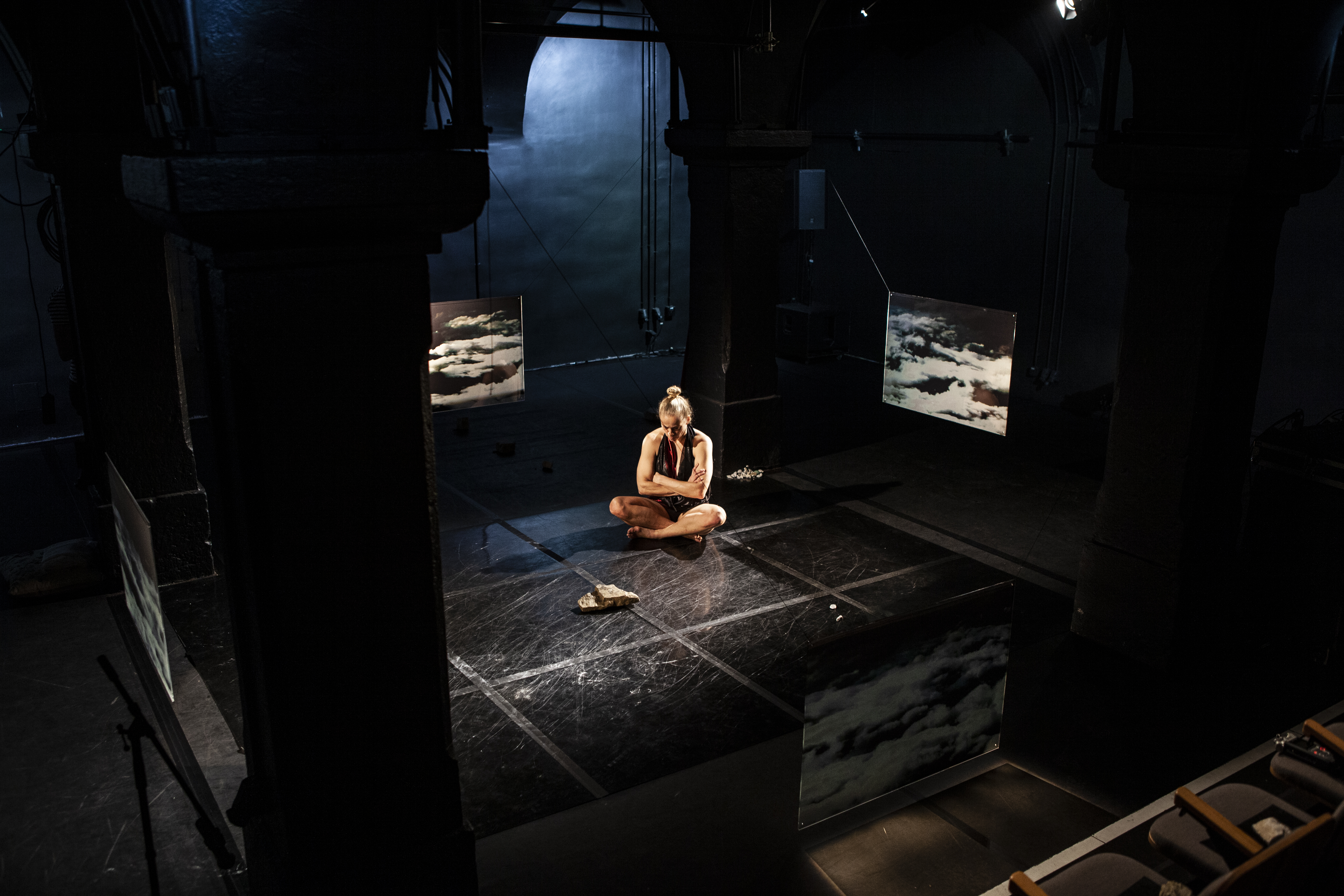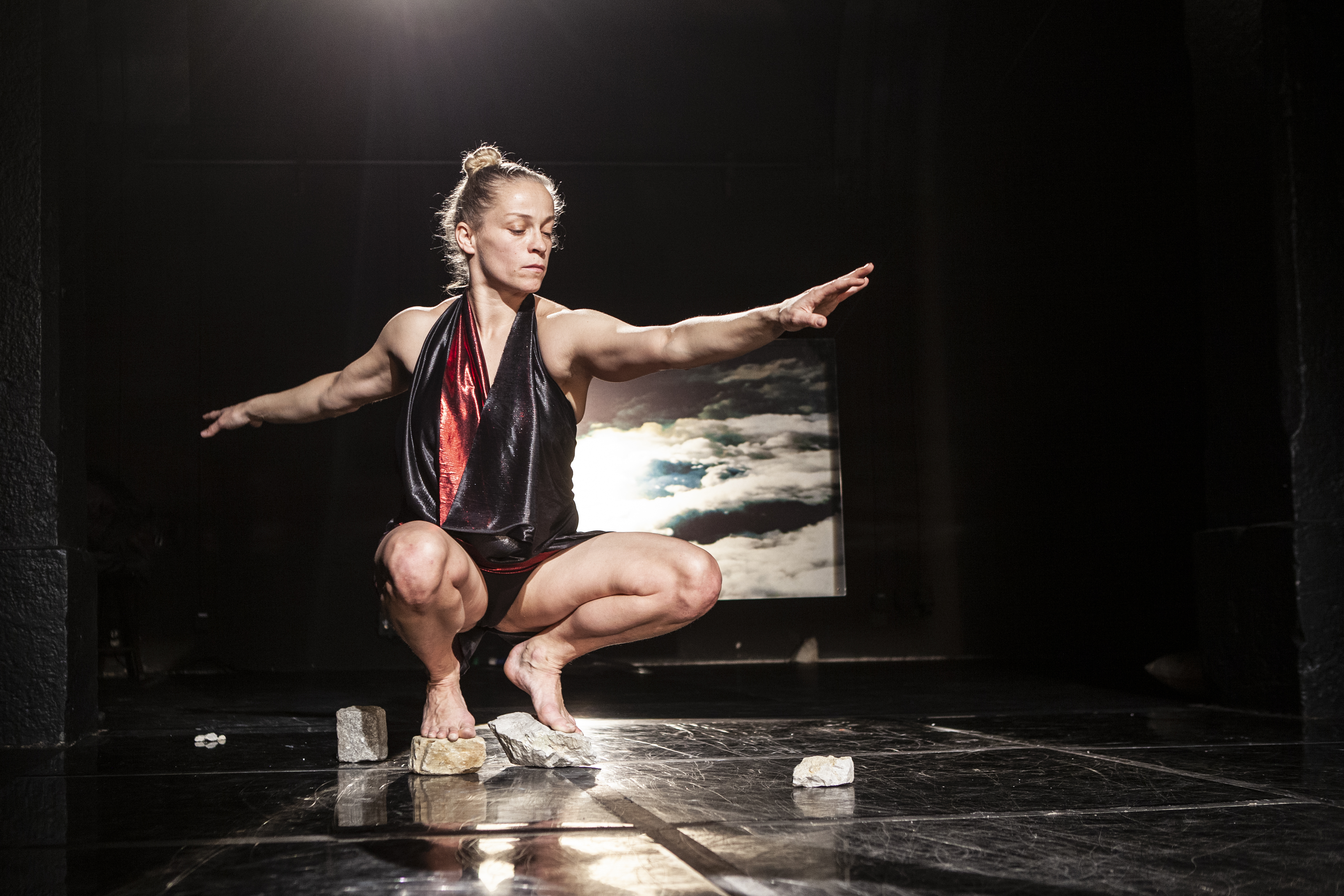


IT IS IMPOSSIBLE TO WAIT IN VAIN
EN
Leja Jurišić and Miklavž Komelj met one night in Metelkova. Jurišić was dancing. When she stoppped, Komelj came to her. They were laughing, but noone remembers why anymore. But most importantly: their collaboration already began. “Everything is sublime,” will be written somewhere later. This concludes a triology of duets by Leja Jurišić. After she worked with Marko Mandić (Together, 2018) and Milko Lazar (De facto, 2019), she became close with Komelj. A scenographer Petra Veber, her long-time co-worker, is also there. It Is Impossible to Wait in Vain starts building up.It is a project, divided into three parts: book of dramatic poem, book of paintings and a performance. Each element stands as an autonomous work of art, but it is only possible through authors close process of collaboration. Giving oneself to the other, in order to make it possible formine to exist. Interconsecration. Komelj sometimes finds it easier to visita dentist, than to attend a theatre. Maybe this is the reason why Jurišić communicates with a stone in the performance. This is precisely why “a stone is not a prop for Jurišić”, as Komelj emphasized. Stone is a co-actor. “Stone assumes ultimate difference, otherness, and perhaps this is a reason, why it also presents equality andoneness. Stone symbolizes immobility and insistance,” Jurišić adds. By that he “encourages a desire for closeness, for understanding.”It is Impossible to Wait in Vain sketches, declares and performs close connections between worlds far apart. Passionate poetics of Komelj and penetration of extremes by Jurišić. One with the other, and one in the other, both on a path towards empathic aspiration. Jurišić continues to ask herself: “Who truly dares to question the position of power-over?”
SI
Leja Jurišić in Miklavž Komelj sta se spoznala nekega večera na Metelkovi. Jurišić je plesala, Komelj je, ko ni več plesala, pristopil, smejala sta se, nihče več ne pomni, zakaj. A bistveno: sodelovanje se je s tem že pričelo. Vse je sublimno, bo nekje pisalo.In tako se trilogija duetov Leje Jurišić približuje k zaokrožitvi. Po sodelovanju z Markom Mandićem (Skupaj, 2018) in Milkom Lazarjem (De facto, 2019) se torej Jurišić zbliža s Komeljem. Lejina dolgoletna sodelavka, scenografka Petra Veber, je tudi tam. Nastaja Ni mogoče čakati zaman, tripartitno delo, sestavljeno iz dramske pesnitve, knjige slik in predstave. Vsak element je samostojno delo, a nastaja lahko le skozi procesualno prepletanje obeh avtorjev. Posvečenost drugemu, da bi moje sploh lahko bilo. Interposvečenost. Komelju je obisk zobozdravnika včasih manj neprijeten kot obisk gledališča. Vse je v mehkosti. Morda zato Jurišić v tem delu komunicira s kamnom.
Natanko zato “kamen za Jurišić ni rekvizit”, poudari Komelj, soigralec je. Jurišić pa doda: “Kamen predpostavlja ultimativno drugačnost, drugost in mogoče zato enost ali enakost. Kamen simbolizira nepremičnost, vztrajanje.” Prav s tem “spodbuja željo po približanju, po razumevanju.”
Ni mogoče čakati zaman izrisuje, izpoveduje in izvaja bližnje vezi med oddaljenimi svetovi. Komeljeva strastna poetskost in penetriranje skrajnosti eksistence pri Jurišičevi, drug z drugim in drug v drugem na poti empatičnega prizadevanja. Jurišič se nenehno sprašuje: “Kdo je v resnici pripravljen preizpraševati mesto premoči?”
CREDITS
Authors: Leja Jurišić and Miklavž Komelj
Author of performance It is Impossible to Wait in Vain - a practical mystery: Leja Jurišić Performers: Leja Jurišić and a rock Scenography, lights, costumes: Petra Veber
Filming: mali film, Hana Vodeb, Vid Hajnšek
Technical director: Grega Mohorčič Technical support: Simon Bezek, Brina Ivanetič, Žan Rantaša
Author of the book It is Impossible to Wait in Vain - a static mystery: Miklavž Komelj
Author of the book of paintings: Miklavž Komelj
Editor of Glej, Paper: Tery Žeželj Designers of posters, books and Glej, Paper: Mina Fina, Ivian Kan Mujezinović / Grupa Ee Photography: Ivian Kan Mujezinović, Matija Lukić, Petra Veber
Producers: Barbara Poček (Glej Theatre), Žiga Predan (Pekinpah) Post production: Inga Remeta (Glej Theatre), Žiga Predan (Pekinpah)
Production and co-production: Glej Theatre and Pekinpah with Leja Jurišić
Production of books: Pekinpah
Co-financers: Ministry of Culture and Municipality of Ljubljana
SHOWS
GLEDALIŠČE GLEJ, premiere, 4th December 2020,
Ljubljana, Slovenija.
GLEDALIŠČE GLEJ,
20th, 21st March 2021,
8th, 9th May 2021,
Ljubljana, Slovenija.
TRIGGER 2021, 30th May 2021, Ljubljana, Slovenija.
GIBANICA 2021 - Biennale of Slovenian Dance,
17th September 2021,
Ljubljana, Slovenija.
PRESS
EN
Leja questions places or roles of (over)power with relationships with stones, even making connection to the traditional gender division, when she brings an ironing board to the stone and lets him know that it would be nice if he used it. At certain point, she intentionally eliminates a few pieces, and consequently her co-players, from the chessboard, so that they stagnate. We could relate this to co-determination about the presence of coexisting beings in our lives in general, about the place of relationships, abandonment or termination of relationships – anything really. We could also say that the elimination of stones is a consequence of their response - that is, the lack of the latter. Or that they simply weren’t breathed life into.Živa Kadunc, Koridor-ku.si, 25. September 2021
The stone is definitely better than the camera. It doesn’t connect, it doesn’t interfere, it just exists. If I come to the theater for some miracle, I didn’t wait in vain. Because waiting alone is that fulfillment. It doesn’t happen at the end but in a continuous recurrence.
Ana Lorger, Neodvisni.art, Practical Mistery of Duration, 25. May 2021
SI
Leja prevprašuje mesta ali vloge (pre)moči z odnosi s kamni, naveže celo na tradicionalno delitev moških in ženskih vlog, ko kamnu prinese likalno desko in mu da vedeti, da bi bilo lepo, če bi jo uporabil. Na neki točki namenoma izloči nekaj figur, posledično tudi soigralcev, s polja šahovnice, tako da stagnirajo. Lahko bi to navezali na soodločanje o prisotnosti sobivajočih bitij v naših življenjih nasploh, o umestitvi odnosov, razmerij, opustitve ali prenehanje odnosov – karkoli zares. Lahko bi rekli tudi, da so izločitve kamnov posledice njihovega odziva – torej pomanjkanje slednjega. Ali zgolj to, da njim ni bilo vdahnjeno življenje.Koridor-ku.si, Živa Kadunc, 25. september 202
Kamen je vsekakor boljši od kamere. Ne povezuje, ne preči, ampak zgolj obstaja. Če v gledališče prihajam po čudež, nisem čakala zaman. Ker čakanje samo je ta izpolnitev. Ne zgodi se ob koncu, temveč v vedno vnovični ponovitvi.
Neodvisni.art, Praktični misterij trajanja, Ana Lorger, 25. maj 2021
READ MORE PRESS︎︎︎